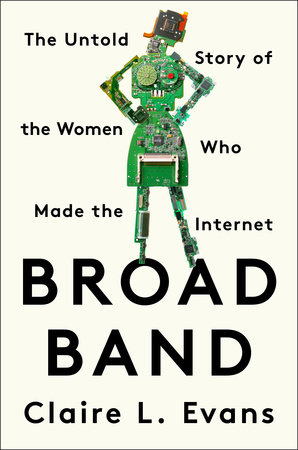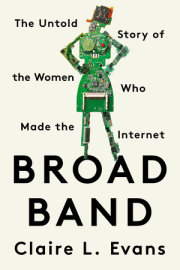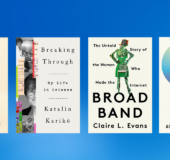Chapter One
A Computer Wanted
It's 1892 in New York City. In January, an immigration processing center called Ellis Island opened for business. In March, in Springfield, Massachusetts, a YMCA instructor desperate to keep a class of stir-crazy youngsters entertained indoors hosted the first public game of "basket ball." But the winter is over, and it's the first of May, just shy of spring, just shy of the twentieth century. It's before the screen, the mouse, the byte, the pixel, and one hundred years before my Dell, but there's a strange notice in the classified pages of the New York Times.
"A Computer Wanted," it says.
This ad is the first instance of the word "computer" in print. It wasn't placed by an indiscreet time-traveler, someone trapped in the Gilded Age and jonesing for the familiar glow of their MacBook. It was placed by the United States Naval Observatory in Washington, DC, which was by then several decades into a mathematical astronomy project: calculating, by hand, the positions of the sun, stars, moon, and planets across the night sky. The observatory's directors were not in the market, that spring, to buy a computer. They were looking to hire one.
For close to two hundred years, a computer was a job. As in someone who computes, or performs computations, for a living. Had one been browsing the Times that May Day in 1892 and decided to answer the classified ad, they'd soon be taking an algebra test. The Naval Observatory job was cushy, relatively: those who lived nearby worked in a cozy, informal office in Cambridge, far from the observatory itself, which was perched on a bluff above the Potomac. They clocked five-hour days, charting the skies from individual tables by a roaring fire, pausing often to discuss the scientific ideas of the day. The rest worked from home, from detailed mathematical plans they received in the mail. Computing, as one historian has noted, was the original cottage industry.
Every day, these computers-much as computers do today-would chip away at complicated, large-scale math problems. They wouldn't do it alone. Our new hire would be part of a team: everyone crunching their share of the numbers, some correcting each other's work for extra income. With pen and paper alone, the Naval Observatory team would chart the skies, just as other computing offices throughout the Western world would advance ballistics, maritime navigation, or pure mathematics. They wouldn't receive much individual credit, but whatever the problem was, they'd have been instrumental in solving it.
Computing offices were thinking factories. The nineteenth-century British mathematician Charles Babbage, whose desire to calculate by steam led to important early developments in mechanical computing, called what the human computing offices of his time did "mental labor." He considered it work one did with the brain, just as hammering a nail is work one does with the arm. Indeed, computing was the grunt labor of organized science; before they were made obsolete, human computers prepared ballistics trajectories for the United States Army, cracked Nazi codes at Bletchley Park, crunched astronomical data at Harvard, and assisted numerical studies of nuclear fission on the Manhattan Project. Despite the diversity of their work, human computers had one thing in common. They were women.
Mostly, anyway. The Naval Observatory hired only one female computer for its Nautical Almanac Office, although she was by far the most famous among them: Maria Mitchell, a Quaker from Nantucket Island, who had won a medal from the king of Denmark before she was thirty for discovering a new comet in the night sky. It came to be known as "Miss Mitchell's Comet." At the observatory, Mitchell calculated the ephemeris of Venus, being, as her supervisor told her, the only computer fair enough to tackle the fairest of the planets.
Her presence as a woman in a computing group was unusual for its time, but it would only become less so. Maria Mitchell discovered her comet only a year before the Seneca Falls Conference on the Rights of Women, which was largely organized by Quaker activists. Her church was the sole religious denomination allowing women to preach to its congregations, and Maria's father, an amateur astronomer, lobbied aggressively for her accomplishments to be recognized. Before the end of the twentieth century, computing would become largely the purview of women. Female mental laborers, breaking intractable problems down into numerical steps much as machines tackle problems today, ushered in an era of large-scale scientific research.
By the mid-twentieth century, computing was so much considered a woman's job that when computing machines came along, evolving alongside and largely independently from their human counterparts, mathematicians would guesstimate their horsepower by invoking "girl-years," and describe units of machine labor as equivalent to one "kilogirl." This is the story of the kilogirls. It begins, as the most beautiful patterns do, with a loom.
The Spider Work
The loom is a simple technology, but in the warp and weft of thread lies the weaving of all technologically literate society. Textiles are central to the business of being human, and like software, they are encoded with meaning. Every cloth is a record of its weaving, an interconnected matrix of skills, time, materials, and personnel. As the British cultural theorist Sadie Plant observes, "the visible pattern" of any cloth "is integral to the process which produced it; the program and the pattern are continuous." This process, of course, historically concerns women. Around looms, in sewing circles, in ancient Egypt and China, and in southeastern Europe five centuries before Christianity, women have woven clothing, shelter, the materials of writing, even currency.
Like many accepted patterns, this was disrupted by the Industrial Revolution, when a French weaver, Joseph-Marie Jacquard, proposed a new way to create textile patterns. Unlike a traditional loom, singularly animated by its weaver's ingenuity, Jacquard's invention produced remarkably complex textiles from patterns punched into paper cards, reproducible and consistent beyond a margin of human error. The resulting damask, brocade, and quilted matelassŽ became highly coveted all over Europe, but the impact of Jacquard's loom went far beyond industrial textile production: his punched cards, which separated pattern from process for the first time in history, would eventually find their way into the earliest computers. Patterns encoded on paper, which computer scientists later called "programs," could dictate numbers as easily as thread.
The Jacquard loom put skilled laborers out of work. Some took out their anger on the frames of the new machines, claiming as a folk hero the apocryphal Ned Ludd, a weaver said to have smashed a pair of stocking-frames at the end of the previous century. We use the term Luddite now in the pejorative, to describe anyone with an unreasonable aversion to technology, but the cause was not unpopular in its time. Even Lord Byron sympathized. In his maiden speech to the House of Lords in 1812, he defended the organized framebreakers by comparing the results of a Jacquard loom's mechanical weaving to "spider-work." Privately, he worried that, in his sympathy for the Luddites, he might be taken as "half a framebreaker" himself. He was, of course, not-and he was dead wrong about the spider work, too.
Even as Byron made his case, Jacquard looms were producing a quality and volume of textiles unlike anything the world had ever seen. The mathematician Charles Babbage owned a portrait of Joseph-Marie Jacquard woven from thousands of silk threads using twenty-four thousand punched cards, a weaving so intricate that it was regularly mistaken for an engraving by his guests. And although the portrait was a fine possession, it was the loom itself, and its punch card programs, that really ignited Babbage's imagination. "It is a known fact," Babbage proclaimed, "that the Jacquard loom is capable of weaving any design which the imagination of man may conceive." As long as imagination could be translated into a pattern, it could be infinitely reproduced, in any volume, in any material, in any combination of colors, without degradation. Babbage understood the profundity of the punched-paper program because mathematical formulae work the same way: run them again and again, and they never change.
He was so taken with the Jacquard loom, in fact, that he spent the better part of his life designing computing machines fed by punch cards. To describe how these worked, he even adopted the language of the textile factory, writing of a "store" to hold the numbers and a "mill" where they could be processed, analogous to a modern computer's memory and central processing unit. Numbers would move through Babbage's machines, coming together as thread becomes whole cloth.
Babbage's machines-the Difference Engine, a hand-cranked mechanical calculator designed to tabulate polynomial functions, and the more complex Analytical Engine-were so far ahead of their time that they're generally considered historical anachronisms. His mechanical designs required a level of technical precision never before attempted, although the British government, for whom mathematical tables were a point of national interest, was willing to try. It funded construction of the Difference Engine in 1823, with an initial grant of seventeen hundred pounds; by the time it wrote off the project, nearly twenty years later, having spent ten times as much, there was still nothing to show for what the prime minister had by then determined to be a "very costly toy," and "worthless as far as science is concerned," save some partial models and four hundred square feet of confounding schematic drawings.
The machines made Babbage famous-and perhaps infamous-but very few people alive in his time were mentally equipped to understand what they were supposed to do, let alone how. One of those people was Lord Byron's daughter, Ada. In her short life, she would make one thing certain: that the spider work her father had so disdained would proliferate, unstoppable.
Rays from Every Corner of the Universe
Ada's alchemy was peculiar. She was the child of a passionate yearlong marriage between Byron and a bright, mathematically inclined aristocrat named Anne Isabella Milbanke, or Annabella. Byron was, in a former lover's estimation, "mad, bad, and dangerous to know," his passions Romantic in every sense; Annabella, on the other hand, was so sensible and well-bred that Byron teasingly called her the "Princess of Parallelograms." The couple separated amid rumors that the louche Byron had a more-than-fraternal relationship with his half sister Augusta.
Amid the scandal of that separation, the last thing Annabella wanted was for Ada to inherit any of her father's wildness or to suffer as a consequence of his notoriety. To keep her daughter on the straight and narrow, Annabella began a rigorous course of mathematical instruction from the time Ada was four years old. Math-the opposite of poetry. Or so she thought.
Byron absconded to Italy shortly after Ada's birth. He never made her acquaintance, although he inquired after her often. "Is the Girl imaginative?" he wrote to Augusta, knowing full well that Annabella, who kept their daughter purposefully secluded, would divulge nothing directly. Byron died unromantically of the flu in Greece in 1824, when Ada was only nine. As he died, he called to his valet, "Oh, my poor dear child! My dear Ada! My God, could I have seen her! Give her my blessing!"
His body was returned to England by ship, and huge crowds gathered in the streets of London to see his funeral procession of forty-seven carriages. When Ada finally learned her father's name, she wept for him, although it doesn't appear that she or her mother held his legacy in high esteem-Byron's portrait, in their home, was concealed under heavy drapery until Ada was twenty. But his mercurial spirit was alive in her. "I do not believe that my father was (or ever could have been) such a Poet as I shall be an Analyst; (& Metaphysician)," she wrote to Charles Babbage later in life, "for with me the two go together indissolubly."
Ada's sharp analytical mind was inflected by a wild imagination. Prevented from a formal university education by her gender, she thrived under private tutelage. A precocious and very lonely child, she designed flying machines and marched around the billiard table playing violin. She was also frequently ill, prone to episodes of what was then called hysteria, and barely survived a serious three-year bout of measles, during which Annabella took advantage of her daughter's bedridden condition to double down on schoolwork. But Ada was indomitable, agitated, and charismatic, and when she outpaced-and in one case, seduced-her tutors, she educated herself with books and through correspondence with some of nineteenth-century England's most illustrious minds.
She was only a teenager when she struck up a close friendship with the well-known scientist Mary Somerville, who would answer her questions and encourage her studies. The logician Augustus De Morgan sent her problems by post, only to be astounded by the power of thinking represented in her responses. Had she been a man, he marveled, her "aptitude for grasping the strong points and the real difficulties of first principles" would have made her "an original mathematical investigator, perhaps of first rate eminence." She did not shrink away from difficulty, and she had a peculiar way of learning: she questioned the basic principles of mathematics to drill down to their fundamental meaning and understand them completely.
Ada first met Charles Babbage when she and her mother went to see his Difference Engine, the first of his very expensive, very unfinished mathematical machines, in London. She was seventeen; Babbage was forty-two. He displayed the machine-a piece of it, anyway-in a salon where he hosted Saturday-night soirŽes that attracted the most prominent names in society: Charles Darwin, Michael Faraday, Charles Dickens, the Duke of Wellington. It wasn't long after Ada's ritual debut in court, where she had worn satin and tulle and made whispered pronouncements to her mother about the various dukes to whom she was presented: Wellington, she liked, and the Duke of Orleans, too, but the Duke of Talleyrand? He was an "old monkey."
Ada diligently made the rounds, but she held her social obligations in low esteem. She was, however, immediately mesmerized by Babbage's machine, a hulking block of interlinked brass gears and cogs. "While other visitors gazed at the working of this beautiful instrument with the sort of expression, and I dare say the sort of feeling, that some savages are said to have shown on first seeing a looking-glass or hearing a gun," wrote an onlooker, "Miss Byron, young as she was, understood its working, and saw the great beauty of the invention."
Not long afterward, Ada became Ada Augusta King, after her marriage to a sensible aristocrat a decade her senior, and then, three years later, her husband's peerage elevated, the Countess of Lovelace. By the age of twenty-four, she'd borne three children-one, a son, named after her father-and was managing her family's homes in Surrey and London, but she continued to study mathematics every day, and she remained fascinated by the Difference Engine.
Copyright © 2018 by Claire L. Evans. All rights reserved. No part of this excerpt may be reproduced or reprinted without permission in writing from the publisher.






